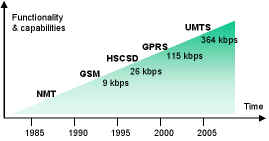|
WAP: Wireless Application Protocol. Makes it possible to show
internet pages on small, handheld devices such as mobile phones
or palm organizers. Today, WAP is restrained by the low speed in
mobile networks; with high-speed networks as GPRS, WAP will be
more user-friendly.
XML: Extensive Markup Language. Defines a platform-neutral
method of communicating data between different systems. XML
allows data to be described in terms of what it actually is; for
example, the information 'Drammensveien 1' could be marked by a
XML tag such as <Home_Address> which would mark a section
of data as containing a customer's home address.
IP: Internet Protocol.
TCP/IP: Network protocol, widely used for transferring data over internet.
FTP: File Transfer Protocol. Used for file transfer over the
Internet. When you download a file from the net, FTP is used to
transfer the file from the web server to your hard disk.
W3C: WWW Consortium. Organization that sets standards
for the Internet.
SET: Secure Electronic Transaction. Standard for safe
transactions mainly used for purchases at web shops.
SSL: Secure Socket Layer. Standard for secure information
transfer.
API: Application Programming Interface. A standard interface
that can be used to communicate or integrate with an
application.
SMS: Short Message Service. Method for sending
short text messages over the GSM Network. A SMS message can be
up to 160 characters long.
P2P: Peer to Peer. Method for direct communication between
end-users. Napster and SMS are examples of P2P services.
OLAP: Online Analytical Processing. Technique used
to present data and look at data from different angels.
EDI: Electronic Data Interchange. Electronic interchange of
structured information directly between computer systems in a
standardized format. Edifact and Odette are examples of EDI
standards.
GSM: Standard for the digital mobile phone network, developed
in Europe but used today in most countries all over the
world.
GPRS: General Packet Radio Service. A standard for data
transfer being implemented in GSM networks. GPRS makes it
possible to be connected to the Internet from a mobile device at
all times, and only pay for transferred data instead of
connection time. GPRS also increases data speed. GPRS makes
mobile internet possible.
UMTS: Universal Mobile Telecommunications System. The next
generation of mobile telecommunications, taking over after NMT
and GSM. In UMTS, speed and data-transfer functionality are
increased compared to GSM with GPRS; it makes multimedia
possible in a mobile environment.
|



